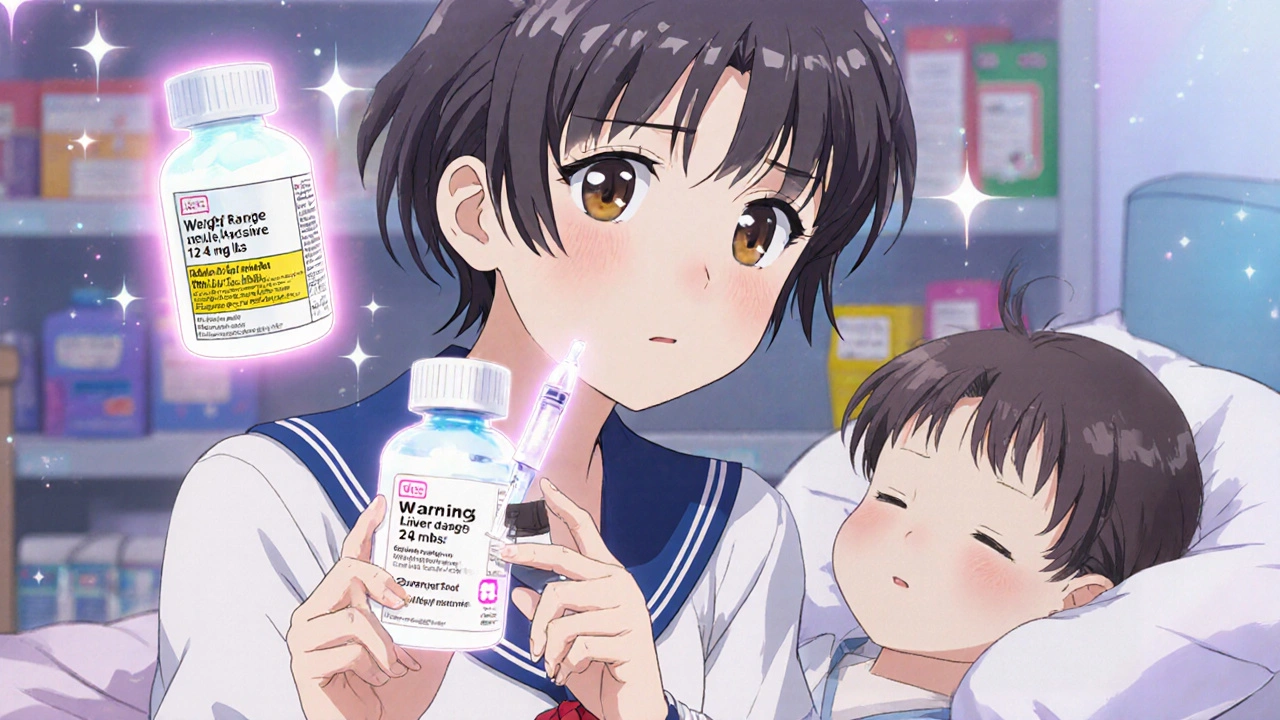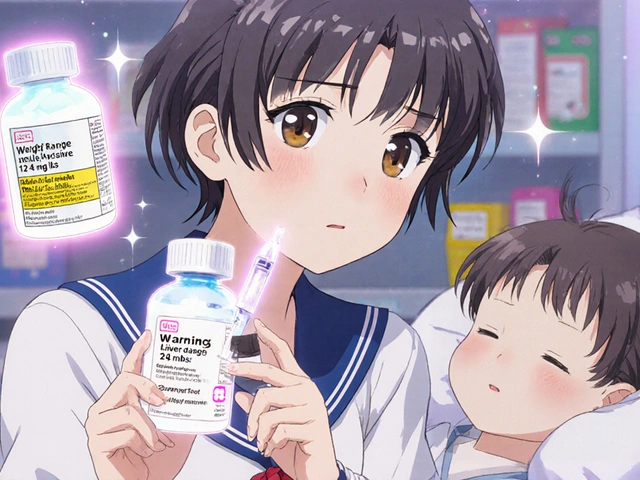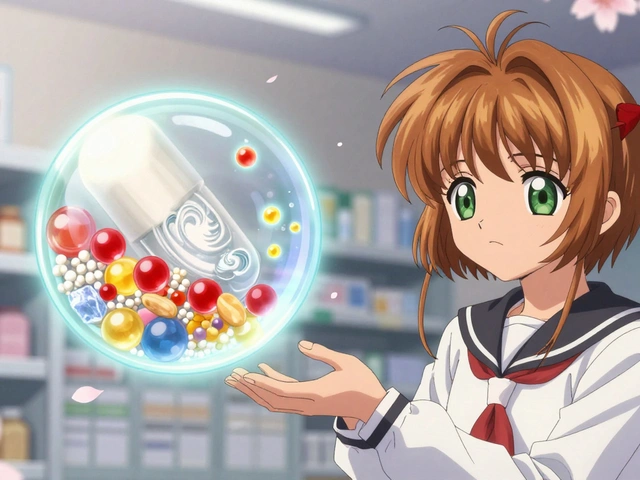Why Weight Matters More Than Age When Giving Kids Medicine
Every year, over a million kids end up in emergency rooms because of mistakes with over-the-counter (OTC) medicine. Most of these errors happen because parents guess the dose based on age alone. But here’s the truth: weight is the only reliable way to know how much medicine your child needs. Age is just a rough guess. Two 4-year-olds can weigh 30 pounds or 55 pounds - and that difference changes the dose dramatically.
The FDA, the American Academy of Pediatrics, and major children’s hospitals all agree: if you know your child’s weight, use it. If you don’t, then use age - but only as a backup. A 2019 study from Johns Hopkins found that using age instead of weight leads to dosing errors in 23% of cases. That’s more than 1 in 5 times. Underdosing means the medicine won’t work. Overdosing can cause liver damage, kidney problems, or even death.
What to Look for on the Label: The 5 Critical Pieces
OTC children’s medicine labels aren’t just instructions - they’re safety tools. Here’s what you need to find before you open the bottle:
- Active ingredient - Is it acetaminophen (like Tylenol) or ibuprofen (like Advil)? Never mix them unless your doctor says so.
- Concentration - This is the most overlooked part. Liquid acetaminophen must be 160 mg per 5 mL. Ibuprofen is 100 mg per 5 mL. If the bottle says 80 mg per 0.8 mL, that’s infant drops - you need a different syringe.
- Weight-based dosing chart - Look for pounds and kilograms. Charts usually break down into 12-17 lbs, 18-23 lbs, 24-35 lbs, and so on. Never skip this.
- Age restrictions - Ibuprofen can’t be given to babies under 6 months. Acetaminophen can be used as early as 2 months, but only with your pediatrician’s approval.
- Maximum daily dose - Acetaminophen: no more than 5 doses in 24 hours. Ibuprofen: no more than 4 doses in 24 hours. Exceeding this risks organ damage.
Acetaminophen vs. Ibuprofen: Key Differences You Can’t Ignore
These two common medicines work differently - and so do their rules.
Acetaminophen (Tylenol):
- Dose every 4-6 hours as needed
- Max: 5 doses in 24 hours
- Concentration: 160 mg per 5 mL (for children’s liquid)
- Can be used from 2 months old (with doctor approval)
- Warning: Overdose is the #1 cause of acute liver failure in children
Ibuprofen (Advil, Motrin):
- Dose every 6-8 hours as needed
- Max: 4 doses in 24 hours
- Concentration: 100 mg per 5 mL
- Not for babies under 6 months
- Warning: Can irritate the stomach - give with food
Notice something? A 24-35 lb child gets 5 mL of acetaminophen - but also 5 mL of ibuprofen. That’s because the concentration is different. Ibuprofen is stronger per milliliter. If you swap them without checking, you could give twice the intended dose.

Never Use a Kitchen Spoon - Here’s What to Use Instead
One parent on Reddit said they gave their 2-year-old 15 mL instead of 5 mL because they thought their teaspoon was accurate. It wasn’t. Household spoons vary by 20-30%. One parent’s teaspoon held 7 mL - meaning their child got 40% more medicine than intended.
The FDA banned teaspoons and tablespoons from labels in 2011. Now, all dosing must be in mL. That’s milliliters. Not teaspoons. Not tablespoons. Not “a splash.”
Use only what comes with the medicine:
- Dosing syringe (plastic, with mL markings)
- Dosing cup (with clear mL lines)
- Oral dosing spoon (only if it’s labeled in mL)
If the medicine didn’t come with one, buy a new one at the pharmacy. They’re free or cost less than a dollar. Never guess. Never improvise.
What to Do When Your Child’s Weight Falls Between Ranges
What if your child weighs 37 pounds? The chart says 36-47 lbs. Easy. Use that range.
What if they weigh 46.5 pounds? Still use the 36-47 lb range.
What if they weigh 48 pounds? Now you switch to the next range: 48-59 lbs.
Here’s the rule: Always round down if you’re unsure. If your child is right on the edge - say, 47.9 lbs - use the lower weight range. It’s safer. Pediatric Associates of NYC and St. Louis Children’s Hospital both recommend this. It’s better to give a slightly lower dose than risk an overdose.
And if your child is under 2 years old? Always call your pediatrician before giving any OTC medicine. Fever in a baby under 3 months is a medical emergency - don’t guess the dose.
Don’t Double Up - The Hidden Danger of Multi-Symptom Cold Medicines
One of the most common mistakes? Giving Tylenol for fever, then giving a cold medicine that also has acetaminophen - without realizing it.
Over 19% of acetaminophen overdoses in children come from this. A parent thinks they’re only giving one medicine. But cold, flu, and allergy products often hide acetaminophen under names like “APAP” or “acetaminophen.”
Check every bottle. If it says “acetaminophen” or “APAP,” don’t give another medicine with it. Even if it’s labeled “for kids.” Even if it’s for a runny nose. Even if it’s from a different brand.
Look for this warning on the label: “Do not use with any other product containing acetaminophen.” That’s your signal to stop.
How to Weigh Your Child at Home (Without a Scale)
You don’t need a pediatric scale. Here’s how to get a good estimate:
- Step on the scale yourself. Write down the number.
- Pick up your child and step on the scale again.
- Subtract your weight from the combined weight.
- That’s your child’s weight.
Example: You weigh 150 lbs. You and your child together weigh 185 lbs. Your child weighs 35 lbs.
Use that number to find the dose on the label. If you’re still unsure, ask your pharmacist. They’re trained for this - and they won’t judge you for asking.
What’s New in 2025: QR Codes, Syringe Units, and More
Labels are getting smarter. By 2025, most children’s medicine bottles will have a QR code. Scan it with your phone and you’ll get a video showing exactly how to measure the dose. Some are already doing this.
The FDA is also testing a new labeling format: adding “syringe units” next to mL. For example: “Give 5 mL (25 syringe units).” This helps parents who still mix up mL and cubic centimeters.
And now, all acetaminophen labels must say “LIVER WARNING” in bold for kids under 12. This is new as of February 2024. It’s there because 47 children had acute liver failure from accidental overdose in just two years.
Final Checklist Before You Give Any Medicine
Before you open the bottle, run through this:
- ✅ Do I know my child’s weight? (If not, estimate it.)
- ✅ Is this medicine acetaminophen or ibuprofen?
- ✅ What’s the concentration? (160 mg/5mL? 100 mg/5mL?)
- ✅ Does the weight match the chart?
- ✅ Am I using the right tool? (Syringe or dosing cup - not a spoon.)
- ✅ Is this the only medicine with acetaminophen in it?
- ✅ Am I giving it within the right time window? (Every 4-6 hours for Tylenol? Every 6-8 hours for Advil?)
- ✅ Am I stopping before the max daily dose?
If you answer yes to all eight - you’re doing it right. If you’re unsure about even one - call your pediatrician. It’s better to wait 10 minutes than risk a trip to the ER.
Can I use the same dosing chart for different brands of children’s Tylenol?
Yes - as long as the concentration is the same. All children’s liquid acetaminophen in the U.S. must be 160 mg per 5 mL. That’s a federal standard. So whether it’s store brand, Tylenol, or generic, if it says 160 mg/5mL, the dosing chart is the same. But if it says 80 mg/0.8 mL, that’s infant drops - different dosing. Always check the concentration first.
My child is under 2 years old. Can I give them OTC medicine without calling the doctor?
No. The American Academy of Pediatrics says: never give acetaminophen or ibuprofen to a child under 2 without talking to your pediatrician first. For babies under 3 months with a fever, call your doctor immediately - don’t give medicine at all. Fever in young infants can be a sign of something serious. OTC medicine masks symptoms, which can delay diagnosis.
Why do some labels say ‘infant drops’ and others say ‘children’s liquid’?
It’s about concentration. Infant drops are stronger: 80 mg per 0.8 mL. Children’s liquid is weaker: 160 mg per 5 mL. That means 0.8 mL of drops equals 5 mL of liquid. If you use the wrong syringe, you’ll give 6 times too much medicine. Always match the dosing tool to the product. Infant drops come with a special dropper. Children’s liquid comes with a cup or syringe. Never swap them.
Is it safe to give ibuprofen to a child with a stomachache?
No. Ibuprofen can irritate the stomach lining, especially if the child hasn’t eaten. It’s not meant for stomach pain. Acetaminophen is safer for general pain or fever. If your child has stomach pain, call your doctor. Don’t guess. Ibuprofen is for inflammation, fever, or muscle pain - not upset stomachs.
What should I do if I accidentally give too much medicine?
Call Poison Control immediately at 1-800-222-1222. Don’t wait for symptoms. Don’t try to make your child vomit. Keep the medicine bottle handy - you’ll need to tell them the exact name, concentration, and amount given. For acetaminophen overdose, treatment is most effective within 8 hours. Time matters.








Julie Pulvino November 23, 2025
This is such a needed post. I used to just guess based on age until my kid had a near-miss with Tylenol. Now I weigh them every few months and keep a note in my phone. Life-changing stuff. Seriously, everyone should read this.
Patrick Marsh November 23, 2025
Never use a kitchen spoon. Ever.
Danny Nicholls November 24, 2025
I literally just bought a dosing syringe after reading this 😭 Thank you for making it so clear. I had no idea infant drops were 6x stronger. My 8-month-old almost got a whole teaspoon of the wrong stuff last week... 🙏 please share this with every new parent you know. Also, QR codes on meds?? That’s next level. 🤯
Latonya Elarms-Radford November 26, 2025
The real tragedy here isn’t just the dosing errors-it’s the systemic abandonment of pediatric nuance in favor of consumer convenience. We’ve turned medicine into a spreadsheet, a checklist, a product to be optimized, not a biological negotiation between caregiver and child. The FDA’s QR codes? A digital Band-Aid on a hemorrhaging system of pharmaceutical paternalism. We’re medicating our way out of empathy, and calling it ‘safety.’ The weight chart isn’t the solution-it’s the symptom. What we need is a return to the relational act of caregiving, not the quantification of love.
Daniel Jean-Baptiste November 26, 2025
good info thanks. i always use the syringe but sometimes forget to check concentration. will start writing it on the bottle now
luke young November 28, 2025
This is the kind of post I wish I’d seen when my daughter was a baby. So clear, so practical. I’m printing this out and taping it to the medicine cabinet. Also, the ‘weigh yourself + kid’ trick? Genius. I’m stealing that.
Michael Fitzpatrick November 29, 2025
I used to think age was enough too. Then I had twins-one was 20 lbs, the other 40 lbs at the same age. Gave them the same dose once. Didn’t realize how close I came to disaster until I read this. I still get nervous every time I open the bottle, but now I have the checklist memorized. Honestly, this saved my sanity. And maybe their lives.
Shawn Daughhetee November 29, 2025
just got back from the er last week because i gave my 18 month old the wrong concentration by accident. i thought it was the same as the last bottle. i didnt even know there were different types. this post is a lifesaver. thank you
Miruna Alexandru December 1, 2025
While the weight-based dosing advice is technically correct, it ignores the fundamental issue: the medical-industrial complex has weaponized parental anxiety to sell more products. The real danger isn’t the dose-it’s the normalization of chemical intervention for every minor symptom. Fever is a defense mechanism. Pain is data. We’ve replaced observation with quantification, and now we’re handing out syringes like candy. This post, while well-intentioned, still operates within the paradigm that children are problems to be solved with chemistry.